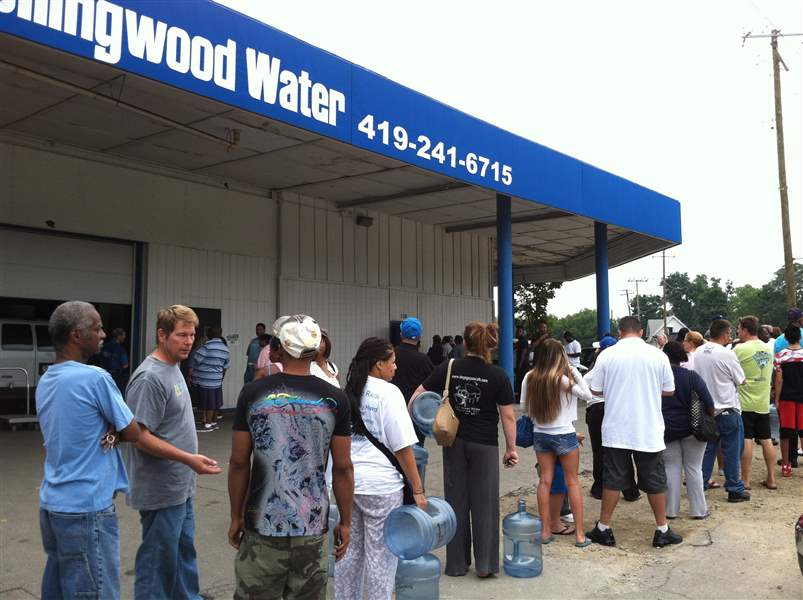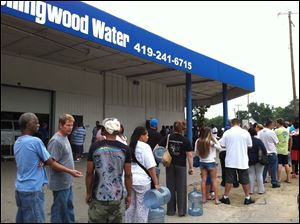
Toledo-area water advisory expected to continue through Sunday as leaders await tests; water stations to remain open
Microcystin found in samples; boiling not recommended
8/2/2014
Scenes like this were common this morning as area residents traveled all over in search of bottled water.
THE BLADE/ JETTA FRASER
Buy This Image

Scenes like this were common this morning as area residents traveled all over in search of bottled water.
Toledo’s public water will remain under a do-not-drink advisory until at least 6 a.m. Sunday pending the return of results from test samples sent out to three different laboratories, Mayor D. Michael Collins said during an evening news conference.
Results from tests sent to the U.S. Environmental Protection Agency in Cincinnati and to a state laboratory in Columbus were expected in later today, but test results from Lake Superior State University in Sault Ste. Marie, Mich., won’t be in until Sunday morning, the mayor said.
City officials also have sent a second sample to U.S. EPA at that agency’s request, Mr. Collins said.
From those three samples, Mr. Collins said, city officials hope to “triangulate” the condition of Toledo’s treated water, which city tests conducted Friday night and early Saturday indicated is contaminated with microcystin toxin, a product of burgeoning algae blooms on Lake Erie. The result was a water crisis that has affected 500,000 water users in and around Toledo and caused Ohio Gov. John Kasich to declare a state of emergency.
The data from the two city tests, the mayor said, “is very confusing for everyone” -- a key reason why Toledo has sought outside analysis.
“We really don’t have a true answer. One set of tests is different from the other,” he said. “...We don’t know for sure these [city] tests are proof positive, but certainly we’re not taking any risks.”
Mr. Collins was confident, however, that the algae crisis will bring about permanent change in how Lake Erie and other natural resources are managed. He faulted agricultural fertilizer runoff, sewage overflows “up in Michigan,” and other pollution for Toledo’s problem.
“I don’t believe we’ll ever be back to normal,” the mayor said. “But this is not going to be our new normal. We’re going to fix this. Our city is not going to be abandoned.”
Water was expected to be available again Sunday at several locations, including Woodmore, Waite, Central Catholic, and Springfield high schools, as well at least two fire stations in Oregon, among other potential locations.
“I think this is a wake-up call," U.S. Sen. Rob Portman (R., Ohio) said after meeting with an array of officials to discuss the emergency response this afternoon. "We do have a problem with these toxic algal blooms" which affect both drinking water safety and Lake Erie's fishing and tourism industries, he said.
PHOTO GALLERY: Advisory sends residents scrambling
RELATED: Join the conversation using #emptyGlassCity
RELATED: Going to great lengths for bottled water
RELATED: Water distribution centers set up in communities
RELATED: Amid water crisis, acts of goodwill
The nearby city of Oregon, which also draws its water from Lake Erie, said that its water was safe during a testing today.
Workers at the city‘s treatment plant told The Blade during an interview inside the plant’s laboratory today that they started seeing suspicious resultings at the plant sometime later Friday. The first signs of algae toxins started appearing in early July, but they were not at high levels and they also were treatable, officials said.
Last summer, Toledo spent an an additional $1 million on chemicals to help protect the city's water supply from Lake Erie's algae.
Shortly after the bulletin was put online at 2 a.m. today, residents reported empty shelves in water aisles at local grocery stores and carryouts. Water that had been destined for other parts of the state was diverted to northwest Ohio so stores could restock. The National Guard trucked in water from Akron and Piqua, which is north of Dayton. Pre-mixed formula and military meals were delivered to Toledo from Columbus.
Restaurants in the affected area were urged to close unless they can guarantee no consumption of tap water. Bottled water shipments that were destined to other regions were rerouted to Toledo, said Kroger spokesman Jackie Siekmann.
The Federal Emergency Management Agency had an emergency-response team on “standby” to respond to Toledo, but would not be dispatched until a gubernatorial request for aid was made, said Steve Fought, an aid to U.S. Rep. Marcy Kaptur (D., Toledo).
Joe Andrews, Ohio Department of Public Safety spokesman, said the Ohio Department of Rehabilitation and Corrections had converted its milk-bottling plant near Columbus to package drinking water in large bladders.
David Grossman, director of the Toledo-Lucas County Health Department, said a safe level of microcystin is 0, but an allowable level is below 1. At the Collins Park plant, water was testing as high as 2.5 parts per million, Dr. Grossman said. As long as the level remains below 20 parts per million, it is safe to shower and bathe. It is OK to drink well water.
Toledo-area hospitals report more than 100 people came to emergency departments by late afternoon concerned that they drank the water and were feeling ill. ER doctors report that some people came just as a precaution but others displayed symptoms such as upset stomach, dizziness and vomiting.
Toledo
Bedford
Walbridge
Northwood
Troy Township
Perrysburg
Rossford
Walbridge
Lake Township
Maumee
Sylvania
Perrysburg
Perrysburg Township
Ottawa Hills
Erie Township
Village of Metamora
Waterville
Eastern Swan Creek Township
Village of Whitehouse
Luna Pier
Toledo police did not report higher-than-usual call volumes; no major criminal complaints were lodged, although officers did respond to “disturbances” over bottled water and large crowds. Both the Toledo Correctional Institute and the Lucas County jail had enough water to last for several days and also have backup plans should the do-not-drink advisory was extended.
The mad dash for bottled water started early today forcing Toledo-area residents to search far and wide for drinkable water. People, on social media, reported driving as far as Ypsilanti, Mich., Lima, Ohio, and Angola, Ind.
When word went out early today that Toledo‘s tap water was contaminated, Garrett Wieland, of Toledo, heard the news just before 8 a.m. and yelled to his girlfriend not to get in the shower. He then headed out in search of bottled water, ending up a couple blocks from home at the Walgreens at 4580 Monroe St.
He was among a crowd of shoppers who had heard the store had bottled water available, but found the clerks were selling water that had yet to arrive on a truck from the distribution center south of Toledo. Sales were limited to five cases of 24-ounce water bottles per customer and sold out within minutes.
“We were lucky to get some,” Mr. Wieland said. “The line was just crazy and things got a little heated in there.”
Once the entire truckload of water had been pre-sold, the 60 or so customers who were fortunate enough to get some lined up around the store and waited -- at times in the rain -- for the truck to arrive.
Hope Gonzalez, who lives in the Old West End, also was among the shoppers who waited, sometimes sitting on overturned shopping carts or chairs and milk crates that Walgreens employees brought out from the store.
“Lesson learned,” Ms. Gonzalez said. “I will always be buying water everytime I go to the store now. We‘re never getting caught without some water in the house again.”
About two and a half hours after most shoppers had purchased their cases of water, the truck rolled into the Walgreens parking lot, greeted by applause.
In and around Toledo, the water crisis was digitally cataloged on social media with #emptyglasscity, which became a nationally trending topic before noontime. To document the random acts of kindness, the folks behind TedxToledo promoted the use of #fullglasscity. Each hashtag is a play on the city's nickname, Glass City.
The Village of Pioneer in western Williams County made one of the most generous offers of the day: they will make 600,000 of gallons of potable water available every 24 hours. Those interested must bring their own trucks, containers, or bottles to 409 First St. in the village.
People from outside the impacted area worked their way to Toledo, including a small caravan from Lima bringing 40 cases and 18 gallon jugs of water to give away at a water-distribution event at Central Catholic High School.
Other neighborly acts of kindness were happening around the city, like in Sam Melden's West Toledo neighborhood. His neighbor stopped over this morning, unsolicited, with a case of water for Mr. Melden's family.
“We were sitting on the porch and he said he'd driven into Michigan … I offered to pay for it and he said, 'No, don't worry about it,' ” Mr. Melden said. “It's great. That's what Toledo neighborhoods are all about.”
Contact Taylor Dungjen at tdungjen@theblade.com, or 419-724-6054, or on Twitter @taylordungjen.